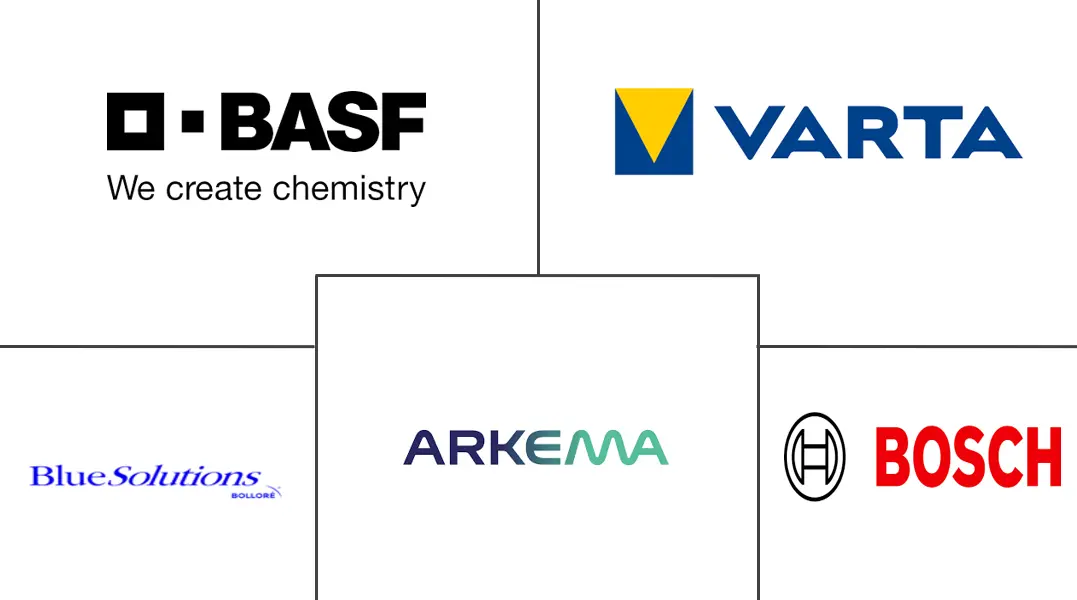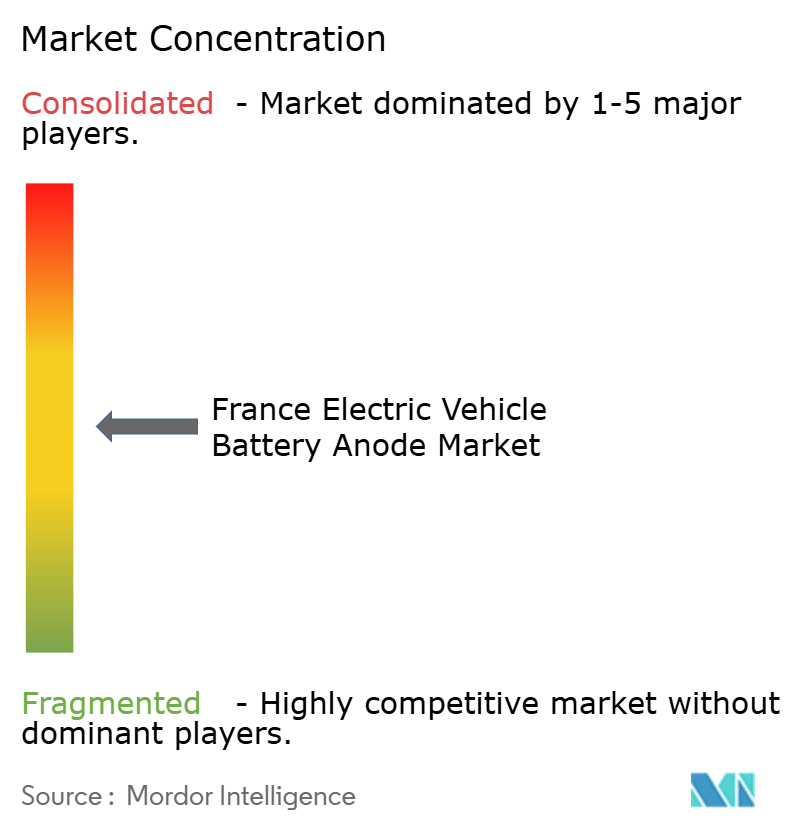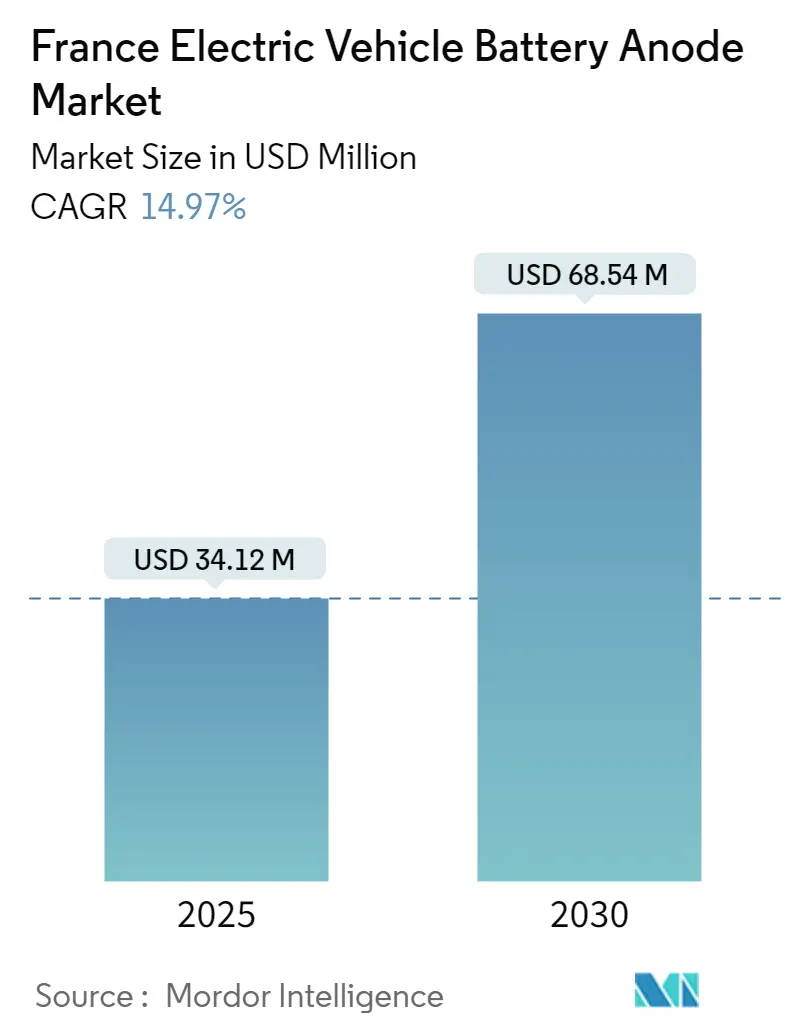
France Electric Vehicle Battery Anode Market Analysis
The France Electric Vehicle Battery Anode Market size is estimated at USD 34.12 million in 2025, and is expected to reach USD 68.54 million by 2030, at a CAGR of 14.97% during the forecast period (2025-2030).
- Over the medium term, the growing EV adoption and technological advancements in anode materials are expected to drive the demand for electric vehicle battery anode during the forecast period.
- On the other hand, the high production costs of advanced anode materials, particularly those that are still in the experimental phase can significantly restrain the growth of the Germany electric vehicle battery anode market.
- Nevertheless, the growing focus on recycling and the circular economy presents opportunities for developing sustainable anode materials and the recycling processe are expected to create significant opportunities for electric vehicle battery anode market in the near future.
France Electric Vehicle Battery Anode Market Trends
Lithium-Ion Battery Type Dominate the Market
- In Germany, the lithium-ion battery, particularly in the electric vehicle (EV) sector, is crucial to the nation's transition towards sustainable transportation. As a global automotive leader, Germany's government is dedicated to advancing and producing state-of-the-art EV battery technologies, with a special focus on the anode, a vital component of lithium-ion batteries.
- The anode is essential in lithium-ion batteries, influencing their capacity, lifespan, and charging speed. Moreover, the cost of these batteries significantly affects electric vehicle pricing. Consequently, the nation's EV battery anode market is of paramount importance in the broader lithium-ion battery landscape.
- For example, a Bloomberg NEF report highlighted that in 2023, battery prices fell to USD 139/kWh, marking a 13% drop from the prior year. With ongoing technological advancements and manufacturing improvements, battery pack prices are projected to further decline, estimating costs at USD 113/kWh by 2025 and USD 80/kWh by 2030. As lithium-ion battery production ramps up due to enhanced manufacturing efficiencies, the unit cost of battery anodes is expected to decrease during the forecast period.
- Moreover, innovations in anode materials are boosting lithium-ion battery performance, making EVs increasingly competitive against traditional internal combustion engine vehicles. Governments in the region are actively championing EV battery innovations, and major companies have recently embarked on projects to enhance anode materials in EV batteries.
- For instance, in December 2023, HPQ Silicon Inc. revealed that its affiliate, NOVACIUM SAS, based in France, obtained a French Tech Emergence Grant of EUR 90,000 (around USD 99,000). This grant is intended to support projects that enhance the entire value chain of advanced SiOx-based anode materials for batteries. A notable trend in the lithium battery domain is the use of 5% to 10% silicon oxide (SiOx) additives in graphite composite electrodes. Such advancements are poised to boost sophisticated battery production in the region and elevate the demand for anodes in battery manufacturing in the years ahead.
- In France, the primary use of anode materials is in lithium-ion batteries for electric vehicles (EVs). These batteries power a range of EVs, from passenger cars to commercial vehicles and public transport. Leading French companies have initiated multiple battery manufacturing projects to meet the surging demand across all EV categories.
- For example, in May 2024, Blue Solutions, a French firm, unveiled plans for a gigafactory in eastern France, with an investment of about 2 billion euros (USD 2.17 billion). This facility aims to produce a new solid-state battery for EVs, boasting a rapid 20-minute charging time, with production slated to commence by 2030. Such initiatives are set to bolster the adoption of lithium-ion batteries as a clean energy solution and heighten the demand for anode materials in the forecast period.
- Thus, these projects and innovations are poised to amplify lithium-ion battery production in the region and escalate the demand for EV battery anodes in the coming years.
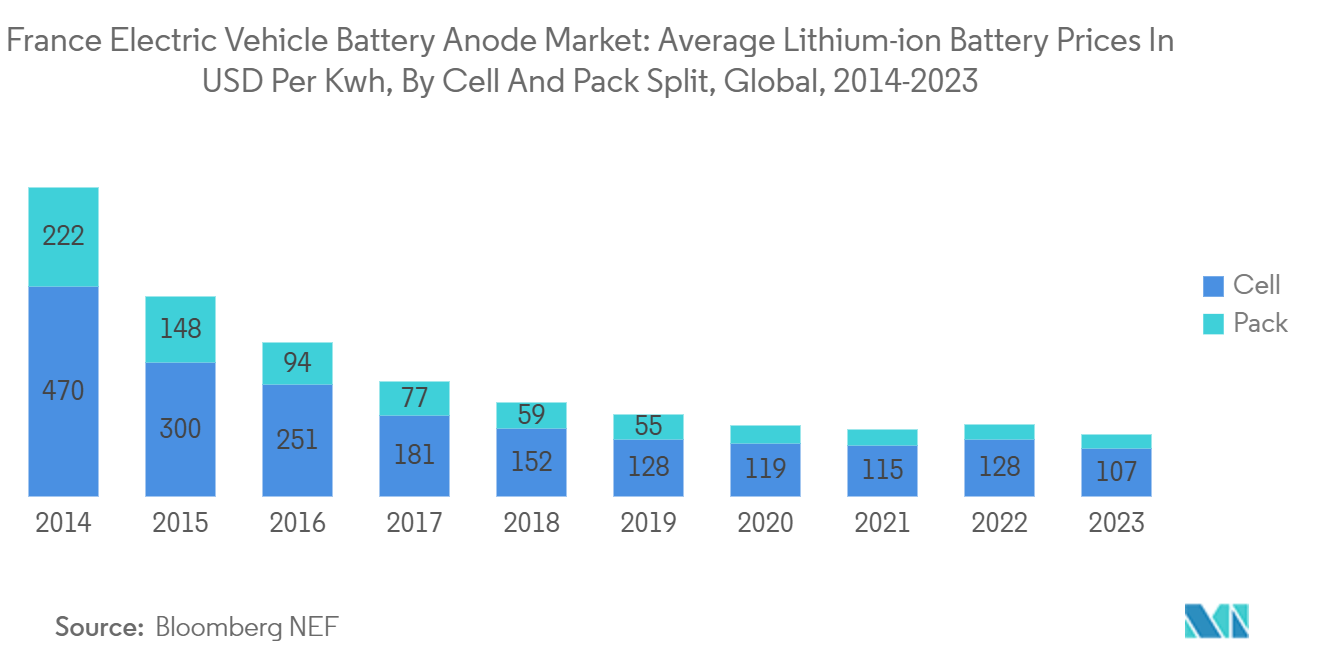
Growing EV adoption drives the Market
- In France, the surging demand for electric vehicles (EVs), driven by changing consumer preferences and regulatory mandates, is propelling the EV battery anode market. This momentum is further bolstered by government incentives and technological strides in battery development, setting the stage for continued market expansion.
- Sales of electric vehicles in the region have seen a meteoric rise in recent years. For instance, the International Energy Agency (IEA) reported that in 2023, France sold 0.47 million electric vehicles, marking a 38.2% increase from 2022. Projections indicate a substantial uptick in electric vehicle sales across the region, subsequently amplifying the demand for battery anode materials.
- Moreover, the French government's subsidies and incentives, aimed at curbing carbon emissions and championing electric mobility, play a crucial role in propelling the market. These initiatives encompass financial backing for EV purchases, tax incentives, and bolstered investments in charging infrastructure. Collectively, they not only boost electric vehicle adoption but also heighten the demand for battery anodes essential for lithium-ion battery production.
- For example, in May 2024, the French government inked a deal with top car manufacturers, setting an ambitious target of 800,000 electric vehicle sales by 2027, a significant leap from 200,000 in 2022. Additionally, the government allocated a substantial 1.5 billion euros (approximately USD 1.6 billion) to bolster electric vehicle production and purchases through diverse initiatives. Such strategic moves are poised to not only accelerate EV production but also amplify the demand for battery anode materials.
- Furthermore, the transition to electric vehicles is pivotal in realizing net-zero carbon emission aspirations. Major companies in the region are actively investing and launching projects to bolster electric vehicle production.
- For instance, in June 2024, BYD Company, a prominent Chinese electric vehicle manufacturer, declared its plans to establish an EV production facility in France, with intentions to introduce plug-in hybrid vehicles (PHEVs) nationwide. This facility is slated to commence operations by the end of next year. Such endeavors are set to boost EV production and, in turn, escalate the demand for battery anodes.
- In summary, these concerted efforts and strategies are anticipated to bolster EV sales and subsequently elevate the demand for anode battery materials in the foreseeable future.
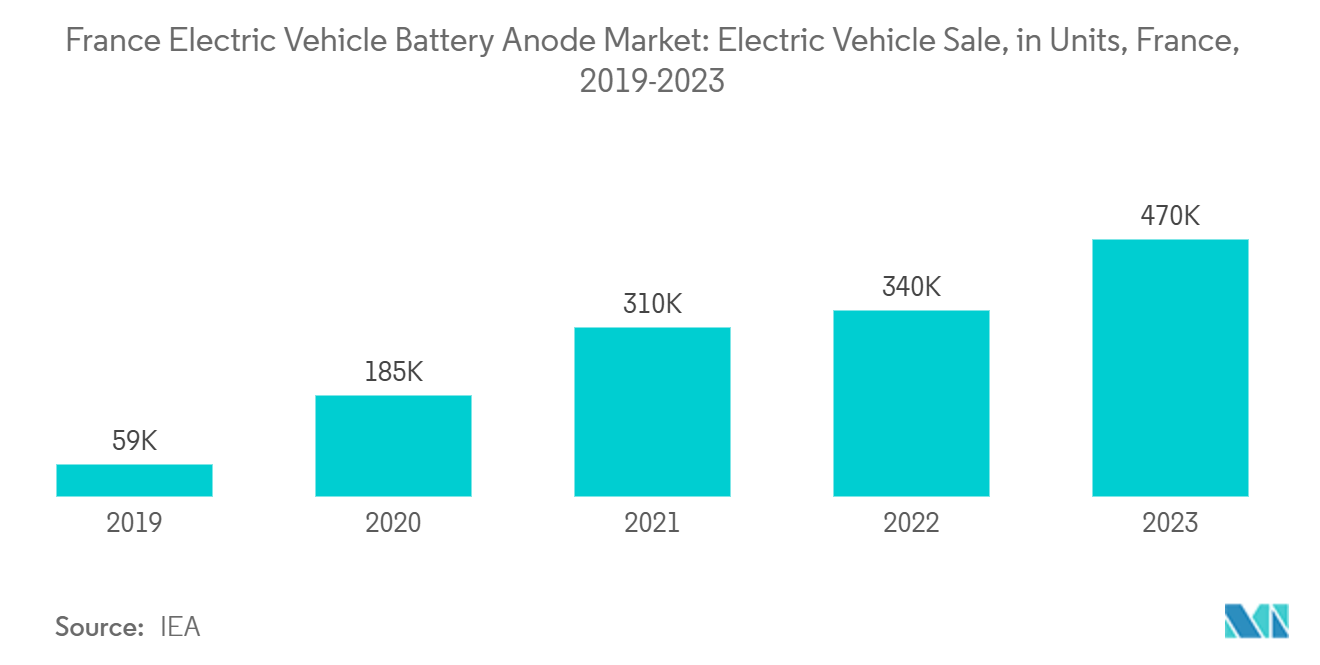
France Electric Vehicle Battery Anode Industry Overview
The France electric vehicle battery anode market is moderate. Some of the key players (not in particular order) are BASF SE, Varta AG, Blue Solutions, Arkema S.A., Robert Bosch GmbH, among others.
France Electric Vehicle Battery Anode Market Leaders
-
BASF SE
-
Varta AG
-
Blue Solutions
-
Arkema S.A.
-
Robert Bosch GmbH
- *Disclaimer: Major Players sorted in no particular order
France Electric Vehicle Battery Anode Market News
- July 2023: ProLogium Technology Co, a Taiwanese battery manufacturer, announced plans to gradually ramp up its EUR 5.2 billion (USD 5.7 billion) factory in France. This move aims to enhance efficiency and address the recent slowdown in electric vehicle (EV) sales. ProLogium is confident that its innovative technology, which incorporates a ceramic separator, silicon anode, and nickel manganese cobalt (NMC) cathode, will see heightened demand, thanks to its advantages of rapid charging times and high energy density.
- January 2023: Tiamat announced its plans to industrialize sodium-ion batteries, starting with a 5 GWh production plant in northern France. The first phase of this facility, boasting an annual capacity of 700 MWh, is set to be commissioned by the end of 2025, aiming for full production capacity by 2029.
France Electric Vehicle Battery Anode Industry Segmentation
An EV (Electric Vehicle) battery anode is one of the two electrodes in a lithium-ion battery, the other being the cathode. In the context of an EV battery, the anode is the electrode where lithium ions are stored during the charging process.
The France electric vehicle battery anode market is segmented by Battery Type and Material Type. By battery type, the market is segmented into Lithium-Ion Batteries, Lead-Acid Batteries, and Others. By Material, the market is segmented into Lithium, Graphite, Silicon, and Others. The Report Offers the Market Size and Forecasts in Revenue (USD) for all the Above.
| Battery Type | Lithium-Ion Batteries |
| Lead-Acid Batteries | |
| Others | |
| Material Type | Lithium |
| Graphite | |
| Silicon | |
| Others |
France Electric Vehicle Battery Anode Market Research FAQs
How big is the France Electric Vehicle Battery Anode Market?
The France Electric Vehicle Battery Anode Market size is expected to reach USD 34.12 million in 2025 and grow at a CAGR of 14.97% to reach USD 68.54 million by 2030.
What is the current France Electric Vehicle Battery Anode Market size?
In 2025, the France Electric Vehicle Battery Anode Market size is expected to reach USD 34.12 million.
Who are the key players in France Electric Vehicle Battery Anode Market?
BASF SE, Varta AG, Blue Solutions, Arkema S.A. and Robert Bosch GmbH are the major companies operating in the France Electric Vehicle Battery Anode Market.
What years does this France Electric Vehicle Battery Anode Market cover, and what was the market size in 2024?
In 2024, the France Electric Vehicle Battery Anode Market size was estimated at USD 29.01 million. The report covers the France Electric Vehicle Battery Anode Market historical market size for years: 2019, 2020, 2021, 2022, 2023 and 2024. The report also forecasts the France Electric Vehicle Battery Anode Market size for years: 2025, 2026, 2027, 2028, 2029 and 2030.
France Electric Vehicle Battery Anode Industry Report
Statistics for the 2025 France Electric Vehicle Battery Anode market share, size and revenue growth rate, created by Mordor Intelligence™ Industry Reports. France Electric Vehicle Battery Anode analysis includes a market forecast outlook for 2025 to 2030 and historical overview. Get a sample of this industry analysis as a free report PDF download.

